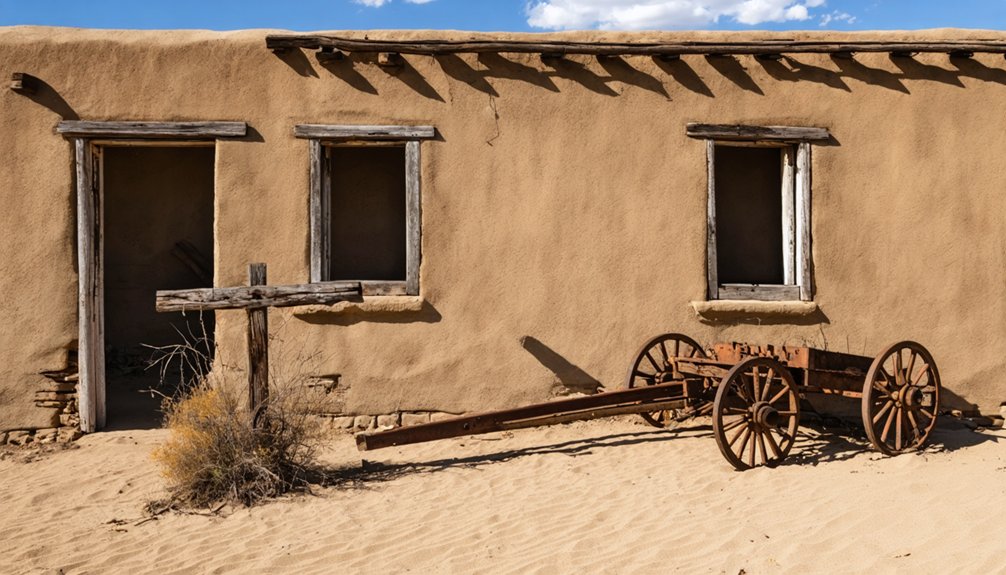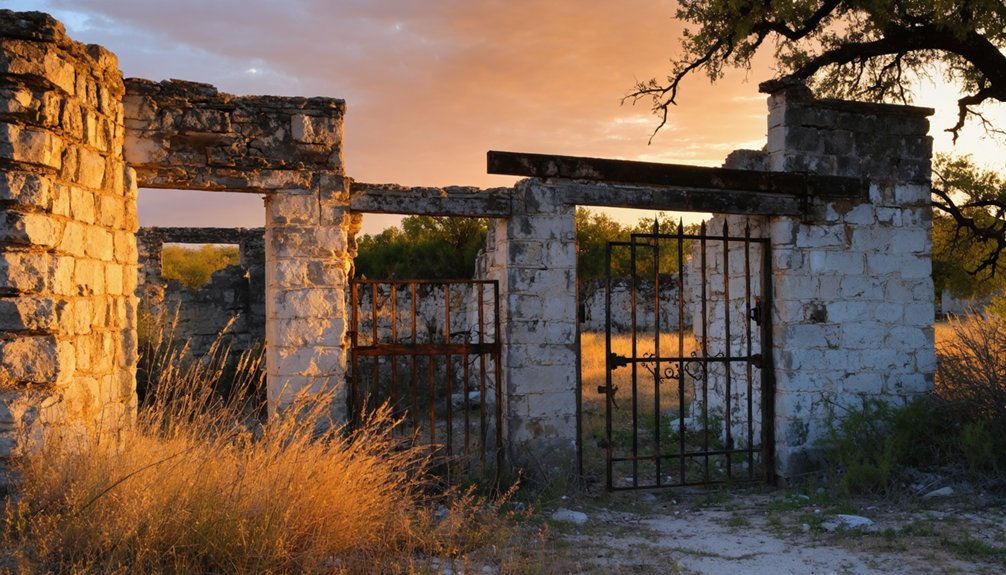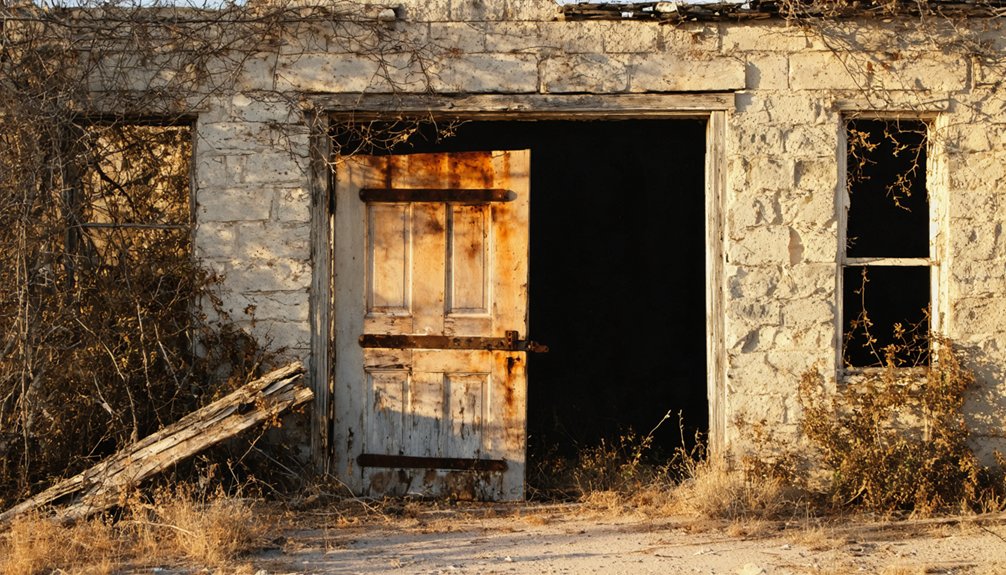You’ll find Las Cabras ghost town in Wilson County, Texas, where it began as a Spanish colonial ranch in the 1750s under Mission Espada. Native American vaqueros managed vast herds of cattle, sheep, and horses from this fortified compound, marked by impressive sandstone walls and defensive towers. Though Apache raids led to its decline, the preserved ruins now stand as a State Archaeological Landmark, holding centuries of stories about frontier life, cultural exchange, and survival.
Key Takeaways
- Las Cabras was established in the 1750s as a ranching outpost of Mission Espada, located 30 miles southeast in Wilson County, Texas.
- The site features impressive sandstone ruins, including defensive towers and thick stone walls built to protect against Apache raids.
- Originally housing vaqueros and indigenous workers managing large herds, the settlement declined due to Apache conflicts and isolation.
- The ghost town was completely abandoned by mid-20th century, though archaeological excavations in the 1970s revealed significant historical artifacts.
- Now protected by the National Park Service, Las Cabras remains a historical site with preserved ruins attracting visitors interested in frontier history.
The Origins of Las Cabras Ranch
While early Spanish missions in Texas focused primarily on religious conversion, the establishment of Rancho de las Cabras in the 1750s marked an important shift toward large-scale ranching operations.
You’ll find this historic ranch about 30 miles southeast of Mission Espada, perched on high ground above the San Antonio River in what’s now Wilson County, Texas.
The ranch establishment came as a direct response to conflicts between Mission Espada and San Antonio’s Canary Islander settlers, who’d complained about mission cattle damaging their crops.
Mission Espada established Rancho de las Cabras after local Canary Islanders protested the damage mission cattle caused to their farmland.
After 1758, a compound was built to house the vaqueros and their families who’d manage the grazing lands. The complex included stone defensive towers to protect against hostile raiders. Here, they’d oversee impressive herds that included thousands of sheep, over a thousand cattle, and hundreds of horses – making Las Cabras a crucial outpost for Mission Espada’s success.
The site evolved substantially under Ana Maria Calvillo’s leadership, as she implemented an irrigation system and mill to expand agricultural production beyond livestock.
Life at the Spanish Mission Ranch
Although mission life centered on religious practices, daily existence at Rancho de las Cabras revolved around the demanding work of livestock management.
You’ll find that ranch life was marked by both freedom and danger, as Native Texan vaqueros managed vast herds some 30 miles from Mission Espada’s protection.
Community resilience proved essential as families faced isolation and threats from Lipan Apache raids. The site operated successfully for over six decades, from 1731 to 1794.
Life at Las Cabras included:
- Living in stone buildings equipped with basic furniture, where vaquero families maintained a frontier lifestyle
- Managing impressive herds – over 1,150 cattle, 740 sheep, and numerous other livestock
- Delivering weekly quotas to the mission while maintaining autonomy in daily operations
These trusted Native American ranchers balanced independence with their mission duties, creating a unique cultural bridge between European ranching and indigenous practices.
Native American Workers and Cultural Impact
Based on Mission Espada records spanning 1753-1767, eleven distinct Native American groups called Rancho de las Cabras home, including the Assaca, Caclote, Caguamama, and Carrizo peoples.
These groups weren’t native to San Antonio but came from south Texas and Tamaulipas, displaced by Spanish colonization along the Rio Grande.
Displaced by Spanish expansion, indigenous peoples from the Rio Grande region sought refuge in the ranching settlements of San Antonio.
You’ll find evidence of their cultural resilience in how they managed large herds – 1,150 cattle, 740 sheep, and more – while facing constant threats from Apache raiders.
Despite isolation from the mission’s military protection, these workers maintained their identity preservation through a delicate balance of mission loyalty and self-governance.
Their permanent presence, managing livestock 30 miles from the mission, created a stable if precarious community that bridged indigenous traditions with colonial agricultural demands.
The workers built a fortified compound with thick stone walls to protect themselves and their livestock from raids.
Archaeological Discoveries and Preservation
Archaeological excavations in the 1970s revealed a remarkable sandstone compound at Rancho de las Cabras, offering tangible proof of the indigenous workers‘ complex society.
Through rigorous archaeological methodologies and artifact analysis, you’ll find extensive evidence of cultural exchange between Native Americans and European settlers. The 1980 summer survey provided crucial data about the site’s historic occupation and archaeological deposits.
The site’s rich discoveries include:
- Multiple construction phases featuring defensive towers, a hexagonal layout, and a chapel
- Diverse artifacts from trash middens including native pottery, European ceramics, and metal objects
- Well-preserved structural elements like kilns, postholes, and wall trenches
Today, you can visit this State Archaeological Landmark under Texas Parks and Wildlife Department protection.
The site’s preservation guarantees future generations can explore this unique blend of indigenous and colonial heritage, though it requires ongoing conservation efforts to protect against environmental damage and looting.
Colonial Ranching Operations
You’ll find that Mission Espada‘s Las Cabras ranch operated with remarkable efficiency, maintaining thousands of livestock through a system of Indigenous vaqueros who managed vast herds of cattle, sheep, and horses across the Texas rangeland.
The ranch’s success relied on carefully structured management practices where Native American workers lived on-site with their families, tending to weekly mission quotas while adapting Spanish colonial ranching methods.
These early Texas vaqueros developed specialized skills in handling livestock under challenging frontier conditions, setting the foundation for what would later become iconic American cowboy culture.
Mission Livestock Management Systems
During the colonial period, Spanish missions in Las Cabras established sophisticated livestock management systems that combined European ranching practices with indigenous labor.
You’ll find that these mission ranches operated as self-sustaining units, where livestock breeding programs focused on improving cattle, horse, and sheep herds. The missions served as essential centers for distributing breeding stock throughout Texas’s frontier regions. Like modern operations that prioritize environmental excellence, the colonial missions implemented careful land management practices to preserve grazing areas. Much like today’s systems that track cattle performance, missions kept detailed records of each animal’s lineage and productivity.
- Extensive corrales (fenced enclosures) protected valuable livestock from predators and theft
- Strategic grazing techniques utilized seasonal movements to optimize forage and water resources
- Basic veterinary care combined Spanish traditions with local indigenous knowledge for animal health
The rancho de ganado system you’d see at Las Cabras included carefully planned infrastructure, from watering points to communal grazing lands, all designed to support successful livestock operations under mission control.
Spanish Colonial Herding Practices
Spanish colonial ranching in Las Cabras emerged through an intricate system of land grants that legitimized large-scale livestock operations beyond mission boundaries.
You’d find vaqueros practicing mounted herding techniques adapted from Spain’s Andalusian traditions, using lassos and specialized ropes to manage cattle across the open range.
Franciscan priests established early ranching operations before expanding beyond the missions.
The crown required you to register your brands and pay taxes on both major livestock (cattle, horses, mules) and minor livestock (sheep, goats).
By 1622, New Spain’s herds had grown to over 225,000 cattle.
You’d need to follow strict regulations under the Bando de Mestenos laws, which declared unbranded animals as government property.
Despite these controls, ranchers developed effective livestock management systems, with vaqueros mastering regional adaptations of Spanish horsemanship.
Their deep knowledge of roping and cattle drives established practices that would influence Texas ranching for generations.
Native Ranch Labor Dynamics
While Mission San Francisco de la Espada maintained overall control of Rancho de las Cabras, native workers from eleven distinct ethnic groups managed the daily operations with remarkable autonomy starting in the 1750s.
This labor diversity brought together displaced peoples from South Texas and Tamaulipas, creating a unique multi-ethnic workforce that operated largely independent from direct colonial oversight.
You’ll find evidence of indigenous autonomy in how these workers:
- Managed substantial herds of over 2,000 animals including cattle, sheep, and horses
- Maintained ranch infrastructure like jacals, corrals, and fencing without direct supervision
- Developed their own semi-autonomous community despite risks from Apache raiders
These native ranchers balanced mission quotas with their own survival needs, operating in relative freedom despite the inherent dangers of their isolated position.
Frontier Challenges and Apache Raids

As threats mounted against Rancho de las Cabras in the 1770s, the remote mission outpost found itself increasingly vulnerable to Apache raids.
You’ll find that the ranch’s position, 30 miles southeast of San Antonio, left its Native Texan inhabitants exposed and far from military protection at Presidio San Antonio de Bejar.
The Apache conflict devastated the once-thriving ranch operations, which had managed impressive herds of over 1,200 cattle and 4,000 sheep.
Before Apache raiders struck, the prosperous ranch maintained vast herds exceeding 1,200 cattle and 4,000 sheep.
The frontier vulnerability became evident as Lipan Apache raiders repeatedly targeted the settlement’s livestock and resources.
Despite the presence of 26 Native vaqueros and their families manning the ranch’s jacals, corrals, and pens, the persistent raids disrupted daily operations and threatened their safety, ultimately contributing to the ranch’s decline and eventual abandonment.
These raids aligned with the broader pattern of Apache tribes conducting small raiding parties for livestock and resources rather than large-scale military campaigns.
The Ruins Today: A Historical Landmark
You’ll find impressive sandstone block walls still standing at the Las Cabras ruins, which include the remains of defensive towers and two original gated entrances from the 18th century.
The National Park Service now protects these historic structures with large sand piles covering unexcavated portions to prevent deterioration and damage.
Through carefully controlled guided tours offered monthly from October to March, you can witness this remarkably preserved example of early Texas ranching heritage.
Standing Stone Wall Remnants
Sandstone blocks rise from the Texas earth at Las Cabras, forming weathered walls that reach heights of 5 to 6 feet along the compound’s northern edge. This historical architecture stands as a manifestation of Spanish Colonial ranching heritage, with walls approximately 2.2 feet wide enclosing an irregular compound that once bustled with livestock activity.
As you explore the cultural heritage site today, you’ll find:
- Defensive bastions at the northwest and southeast corners
- A chapel integrated into the eastern section’s stonework
- Multiple interior rooms adjoining the perimeter walls
The strategic positioning atop a hill overlooking the San Antonio River valley shows you why Spanish colonists chose this location.
These enduring walls once protected valuable livestock and ranch workers from raiders while serving as a crucial outpost for Mission Espada’s ranching operations.
Archaeological Protection Measures
The weathered walls of Las Cabras now stand under robust legal and institutional safeguards. You’ll find this historic ranching outpost protected as both a State Archaeological Landmark and National Register site, with the Texas Parks and Wildlife Department maintaining strict conservation strategies since 1976.
Archaeological ethics guide every aspect of site management, from the Center for Archaeological Research’s careful excavations to the use of non-invasive survey techniques.
You’ll notice thoughtful preservation measures protecting the bastion bases and perimeter walls, while systematic monitoring keeps natural threats like erosion at bay. The Texas Antiquities Committee oversees all research permits, ensuring that any investigations follow proper protocols.
If you visit, you’ll see educational markers that help interpret the site’s rich cultural history while safeguarding its archaeological integrity.
From Mission Ranch to Ghost Town

During the mid-1700s, Mission San Francisco de la Espada established Rancho de las Cabras as a vital livestock outpost, locating it strategically on elevated ground above the San Antonio River.
Mission San Francisco de la Espada chose high ground near the San Antonio River to establish its essential ranching operation.
The rancho economy thrived as Native Texan vaqueros managed substantial herds, creating a unique cultural exchange between Spanish and indigenous practices.
You’ll find the ranch’s shift from mission control to civilian ownership marked by these significant changes:
- The secularization of Spanish missions transferred the lands to former mission inhabitants
- The once-bustling stone compound gradually fell into disrepair
- The settlement never developed into a permanent town, eventually becoming a ghost town
Today, you can still see the ruined stone walls standing as silent witnesses to this important chapter in Texas ranching heritage, now preserved within the San Antonio Missions National Historical Park.
Legacy and Historical Significance
Standing as a tribute to early Texas ranching heritage, Rancho de las Cabras holds unique significance as Wilson County’s only remaining evidence of mission-era ranching operations.
You’ll find archaeological discoveries that reveal a complex frontier life, including sandstone walls, a chapel, and living quarters that protected inhabitants from raids while supporting Mission Espada’s crucial livestock operations.
The ranch exemplifies remarkable cultural exchange between Spanish missionaries, indigenous workers, and local settlers.
Perhaps most prominently, it challenges traditional gender roles through María del Carmen Calvillo‘s pioneering ownership in the early 1800s.
Today, as part of the San Antonio Missions National Historical Park, the site continues to teach visitors about colonial Texas life, frontier defense, and the economic networks that shaped early Texas society.
Frequently Asked Questions
Are There Any Reported Ghost Sightings or Paranormal Activity at Las Cabras?
You won’t find verified ghost encounters or spectral legends at this locale – despite what you’re hoping to discover. While other Texas ghost towns boast paranormal tales, Las Cabras remains mysteriously quiet.
What Happened to the Descendants of the Native American Ranch Workers?
You’ll find that most descendants integrated into local communities, losing direct Native American heritage ties and historical land ownership claims after mission secularization scattered families throughout south Texas in the early 1800s.
Can Visitors Take Guided Tours of the Las Cabras Ruins?
You’ll absolutely love the guided exploration of these breathtaking ruins! You can join monthly tours from October to March, first Saturdays at 9 AM. Just email saan_interpretation@nps.gov to discover this historical significance firsthand.
What Wildlife Species Currently Inhabit the Abandoned Ranch Site?
You’ll spot diverse wildlife including white-tailed deer, coyotes, raccoons, armadillos, and feral hogs. Bird species like cardinals and hawks, plus reptiles such as western diamondback rattlesnakes, thrive in the habitat.
How Much of the Original Ranch Territory Remains Under Historical Protection?
Like footprints in sand, you’ll find that historical preservation protects only the core ranch territory – the original compound and immediate surroundings – through NPS management, not the vast mission grazing lands.
References
- https://www.wilsoncountyhistory.org/talk-rancho-de-las-cabras
- https://sanantonioreport.org/rancho-de-la-cabras-a-forgotten-world-heritage-gem/
- https://npshistory.com/publications/saan/clr-rancho-del-las-cabras.pdf
- https://colfa.utsa.edu/_documents/car/asr-100/asr-121.pdf
- https://en.wikipedia.org/wiki/List_of_ghost_towns_in_Texas
- https://www.texasescapes.com/Ghosts/Ghosts-of-Wilson-County.htm
- https://theclio.com/entry/76317
- https://www.npshistory.com/publications/saan/brochures/rancho-cabras.pdf
- https://www.texasbeyondhistory.net/st-plains/images/he4.html
- https://www.nps.gov/articles/000/rancho.htm



